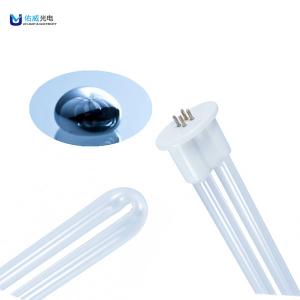oil fume purification equipment UVC lamp 150w ozone generate
Principle of disinfection
Ultraviolet is a kind of low-energy electromagnetic wave. Because
of its good sterilization effect, it is widely used in medical,
sanitation and epidemic prevention, food industry, pharmaceutical
industry and other sectors. However, how to use the ultraviolet
lamp correctly to ensure its sterilization effect, extend the
service life of the lamp tube, and avoid accidental injury is
required for every operator to master first. Now I will talk about
the experience of using it in the past few years. [2]
1 The principle of ultraviolet disinfection
Using ultraviolet radiation, the bacterial protein is photolyzed
and denatured, and the amino acid, nucleic acid and enzyme of the
bacterial body are destroyed and died. At the same time, when
ultraviolet rays pass through the air, the oxygen in the air is
ionized to produce ozone, which strengthens the sterilization
effect. [2]
2Ultraviolet disinfection method
Ultraviolet rays are mostly used for disinfection of air and
surfaces, with a wavelength of 2573A. For air disinfection, the
effective distance does not exceed Zm, the irradiation time is
30~60min, and it is used for disinfection of items. In order to
ionize the oxygen in the air to produce ozone). [2]
3 UV disinfection measures
3.1 Because we all use ultraviolet radiation for air disinfection,
we must first ensure that the lamp is intact and used correctly,
and at the same time, the lamp should be monitored regularly. The
intensity of the ultraviolet lamp should be replaced in time if the
intensity is less than 70uwc/lining. . The lamp should be kept
clean. The surface of the lamp tube should be lightly tested with
an alcohol cotton ball every 1 to 2 weeks to remove dust and
grease, so as to reduce the factors that affect the penetration of
ultraviolet rays. [2]
3.2 The lamp should be handled with care. Turning on the lamp
immediately after turning off the lamp will reduce the lamp life.
It should be cooled for 3-4 minutes and then turned on. It can be
used continuously for 4 hours, but ventilation and heat dissipation
should be good to maintain the life of the lamp. [2]
3.3 The treatment room should be kept clean and dry at all times,
and the treatment room should be wiped with a special cloth soaked
in disinfectant every day. Mop the floor with a special mop. [2]
3.4 Regulate the daily monitoring and registration items of
ultraviolet lamps. It must be registered in separate rooms and
lamps. The registration book includes the lamp activation date,
daily disinfection time, cumulative time, performer's signature,
and intensity monitoring registration. It is required to record
carefully after disinfection, so that The execution is consistent
with the record. [2]
3.5 Use an ultraviolet intensity indicator card or an intensity
monitor to measure the intensity of the lamp first to ensure that
the intensity of the new lamp is 100. Above w/c lining. After
replacing the new lamp, the use time of the mold meter restarts to
count. After the cumulative use time of the lamp reaches 1000h,
contact the professional staff of hospital infection monitoring in
time to monitor the radiation intensity of the lamp. If it is
qualified, continue to use it, and replace it if it is unqualified.
Lamp tube to ensure the disinfection effect of the ultraviolet
lamp. [2]
3.6 When air disinfection, open all cabinet doors, drawers, etc. In
order to ensure that all spaces in the treatment room are fully
exposed, they are all irradiated by ultraviolet rays, and there are
no dead corners in the disinfection as much as possible. [2]
3.7 Strengthen management and supervision of some outpatient
clinics, laboratories and other departments. It is recommended to
install ultraviolet light timer switches in the outpatient
department, which can prevent the waste of power and the effective
life of the lamps due to negligence and forgetting to turn off the
lights. [2]
3.8 The staff should make work arrangements before ultraviolet
disinfection to avoid walking in the sterilization process, which
will affect the disinfection effect and receive unnecessary
exposure; when the monitoring nurse monitors the intensity of the
lamps, due to the large number of lamps, the When monitoring, you
must wear protective glasses and protective clothing; in the ward
with ultraviolet lamps, the switch of the ultraviolet lamp must be
separated from other ordinary lamps or be marked, and the patient
and family members must be explained to the patient and family
members not to turn on the ultraviolet light at will Lights, so as
not to cause undesirable consequences.
" "Precautions
UV-C UV products minimize their risks when used by professionals
who understand how they are used. Users must cover their eyes and
skin to avoid light damage and serious damage to eyes and skin. We
recommend that customers choose equipment carefully and check for
certification from third-party testing, as well as certifications
for equipment materials and electronic components from well-known
agencies such as NSF, UL, CSA, DVGW-OVGW, or other applicable
international requirements."
1. Large-scale domestic sewage treatment, reclaimed water reuse,
disinfection and sterilization of industrial sewage treatment,
drinking water, residential water supply, pure water, high-purity
water;
2. Seawater treatment, central air conditioning, large ventilation
pipes, air disinfection and sterilization.
3. Disinfection and sterilization of various water bodies such as
pure water, domestic water, ionized water, and medical water;
4. Water treatment supporting equipment; Photocatalytic
photocatalyst degrades waste water, and is used in waste water
treatment.
5. Kitchen equipment, cutting boards and tableware disinfection
cabinets, and oil fume pipes to deodorize."


